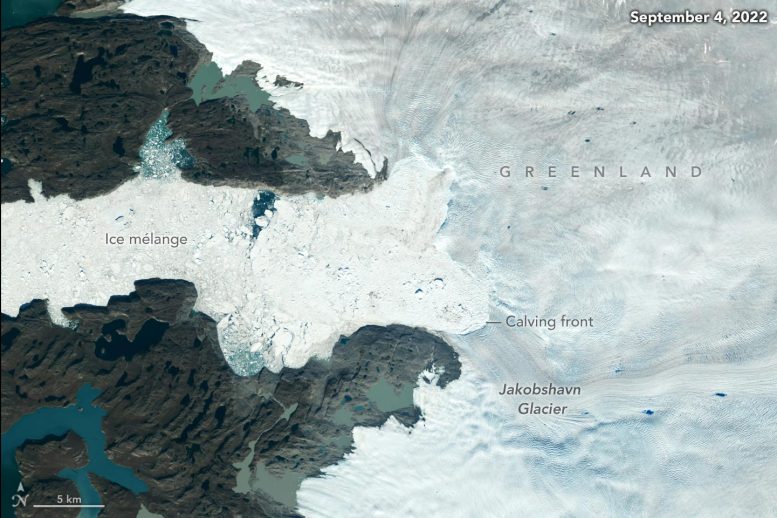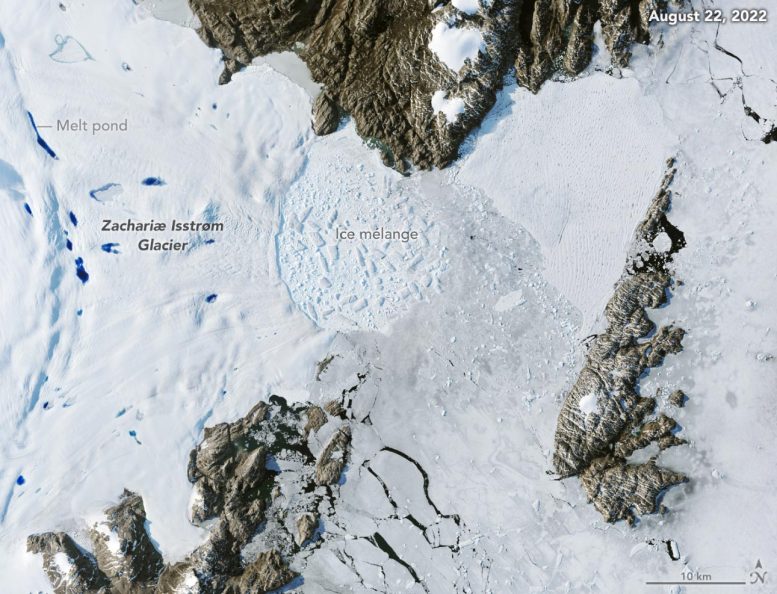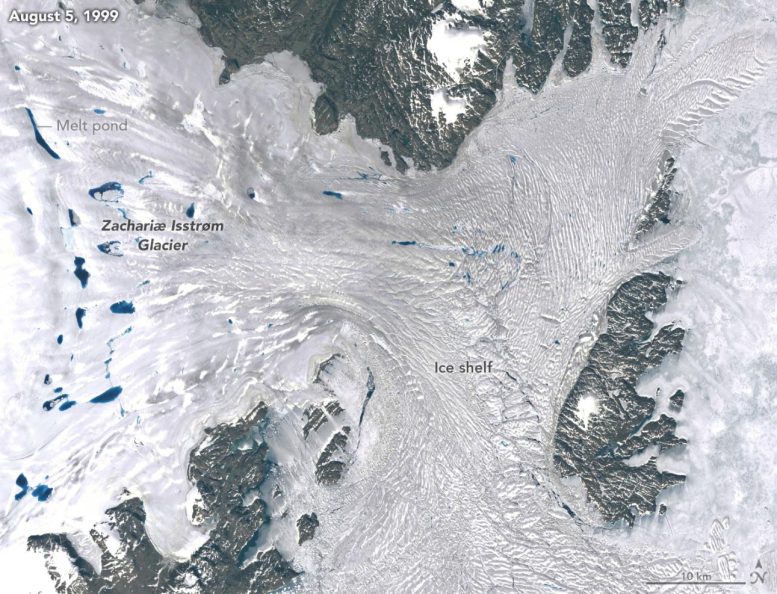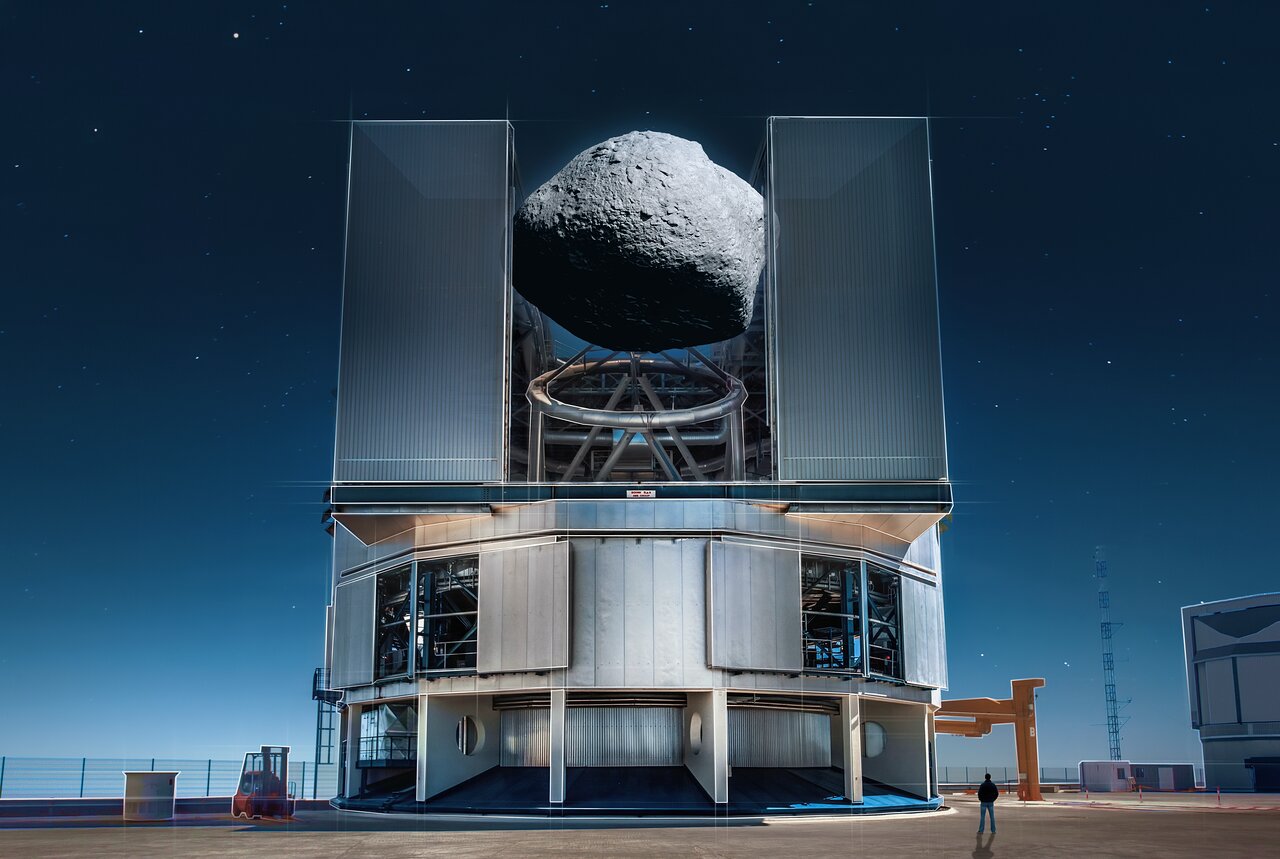 Jakobshavn Isbrae, a glacier on Greenland’s western coast, is shown in imagery taken on September 4, 2022, by Landsat 8, breaking at its edge. According to new findings, the Greenland Ice Sheet has lost about 1,140 billion tons (1,034 billion metric tons) of ice mass from 1985 to 2022 – one-fifth more mass than previously estimated. Credit: NASA/USGSResearchers at NASA’s Jet Propulsion Laboratory in Southern California have reported that the Greenland Ice Sheet has lost approximately one-fifth more ice mass in the last 40 years than earlier estimates. Additionally, most glaciers on the landmass have significantly retreated, with icebergs falling into the ocean at an accelerated rate. While the additional ice loss indirectly impacted sea levels, it could have future implications for ocean circulation. Published in Nature on January 17, the analysis draws from nearly a quarter million pieces of satellite data on glacier positions and provides a comprehensive look at retreat around the edges of the entire ice sheet from 1985 to 2022. Out of the 207 glaciers in the study, 179 have retreated significantly, 27 remained stable, and one advanced slightly.
Jakobshavn Isbrae, a glacier on Greenland’s western coast, is shown in imagery taken on September 4, 2022, by Landsat 8, breaking at its edge. According to new findings, the Greenland Ice Sheet has lost about 1,140 billion tons (1,034 billion metric tons) of ice mass from 1985 to 2022 – one-fifth more mass than previously estimated. Credit: NASA/USGSResearchers at NASA’s Jet Propulsion Laboratory in Southern California have reported that the Greenland Ice Sheet has lost approximately one-fifth more ice mass in the last 40 years than earlier estimates. Additionally, most glaciers on the landmass have significantly retreated, with icebergs falling into the ocean at an accelerated rate. While the additional ice loss indirectly impacted sea levels, it could have future implications for ocean circulation. Published in Nature on January 17, the analysis draws from nearly a quarter million pieces of satellite data on glacier positions and provides a comprehensive look at retreat around the edges of the entire ice sheet from 1985 to 2022. Out of the 207 glaciers in the study, 179 have retreated significantly, 27 remained stable, and one advanced slightly.
Most of the ice loss occurred below sea level in fjords on Greenland’s periphery. Many of these deep coastal valleys, once occupied by ancient glacial ice, have filled with seawater, meaning the ice that broke off made little net contribution to sea level. However, the loss likely accelerated the movement of ice flowing down from higher elevations, which in turn added to sea level rise. Chad Greene, a glacier scientist at JPL and the lead author of the study, explained, “When the ice at the end of a glacier calves and retreats, it’s like pulling the plug out of the fjord, which lets ice drain into the ocean faster.” Jakobshavn Isbrae, a glacier on Greenland’s western coast, is shown in imagery taken on September 5, 1985, by the Landsat 5 satellite. Jakobshavn receded from 1985 to 2022, losing about 97 billion tons (88 billion metric tons) of ice, a recent study of the Greenland Ice Sheet’s glacial retreat found. Credit: NASA/USGSThe findings account for ice lost due to the retreat of terminal glaciers along the edges of Greenland, which had not been considered in earlier assessments. The ice sheet was estimated to have lost about 1,140 billion tons (1,034 billion metric tons) from 1985 to 2022, 21% more mass than previously estimated. While this ice loss does not directly contribute to sea levels, it does represent a significant influx of fresh water to the ocean. Changes in the salinity of the North Atlantic Ocean from melting icebergs could potentially weaken the Atlantic Meridional Overturning Circulation, which could influence global weather patterns and ecosystems.
Jakobshavn Isbrae, a glacier on Greenland’s western coast, is shown in imagery taken on September 5, 1985, by the Landsat 5 satellite. Jakobshavn receded from 1985 to 2022, losing about 97 billion tons (88 billion metric tons) of ice, a recent study of the Greenland Ice Sheet’s glacial retreat found. Credit: NASA/USGSThe findings account for ice lost due to the retreat of terminal glaciers along the edges of Greenland, which had not been considered in earlier assessments. The ice sheet was estimated to have lost about 1,140 billion tons (1,034 billion metric tons) from 1985 to 2022, 21% more mass than previously estimated. While this ice loss does not directly contribute to sea levels, it does represent a significant influx of fresh water to the ocean. Changes in the salinity of the North Atlantic Ocean from melting icebergs could potentially weaken the Atlantic Meridional Overturning Circulation, which could influence global weather patterns and ecosystems.
Icebergs have been breaking off from Greenland’s glaciers for thousands of years as part of a natural cycle, but the new study reveals that ice retreat has surpassed growth throughout the 21st century. Greenland’s ice extent remained relatively steady from 1985 to 2000, then began a marked recession that continues to this day. A Landsat 8 image from August 22, 2022, shows icebergs breaking from Zachariae Isstrom. From 1985 to 2022, as icebergs fell into the ocean at an accelerating rate, the Greenland Ice Sheet shed about 1,140 billion tons (1,034 billion metric tons) – one-fifth more mass than previously estimated. Credit: NASA/USGSThe study also highlighted that Zachariae Isstrom, a glacier in northeast Greenland, lost the most ice, dropping 176 billion tons (160 billion metric tons) due to retreat. This was followed by Jakobshavn Isbrae on the western coast, which lost an estimated 97 billion tons (88 billion metric tons), and Humboldt Gletscher in the northwest, which lost 96 billion tons (87 billion metric tons).Qajuuttap Sermia in southern Greenland was the only glacier that experienced growth over the study period, but its gains were too small to offset the losses from other glaciers.
A Landsat 8 image from August 22, 2022, shows icebergs breaking from Zachariae Isstrom. From 1985 to 2022, as icebergs fell into the ocean at an accelerating rate, the Greenland Ice Sheet shed about 1,140 billion tons (1,034 billion metric tons) – one-fifth more mass than previously estimated. Credit: NASA/USGSThe study also highlighted that Zachariae Isstrom, a glacier in northeast Greenland, lost the most ice, dropping 176 billion tons (160 billion metric tons) due to retreat. This was followed by Jakobshavn Isbrae on the western coast, which lost an estimated 97 billion tons (88 billion metric tons), and Humboldt Gletscher in the northwest, which lost 96 billion tons (87 billion metric tons).Qajuuttap Sermia in southern Greenland was the only glacier that experienced growth over the study period, but its gains were too small to offset the losses from other glaciers. Imagery from the Landsat 7 satellite taken on August 5, 1999, shows Zachariae Isstrom, a glacier in northeast Greenland. This glacier lost about 176 billion tons (160 billion metric tons) of ice during its retreat from 1985 to 2022, a recent study found. Credit: NASA/USGSA correlation was found between the glaciers with the largest seasonal fluctuations in the position of their ice front and the greatest overall retreat. This suggests that glaciers most sensitive to summer warming will be most affected by climate change in the coming decades. The study drew from five publicly available datasets that tracked the month-to-month positions of 236,328 glacier edges as detected in satellite images. According to JPL cryosphere scientist Alex Gardner, a co-author of the paper, this comprehensive view of the ice sheet has provided significant insights that were previously unavailable.
Imagery from the Landsat 7 satellite taken on August 5, 1999, shows Zachariae Isstrom, a glacier in northeast Greenland. This glacier lost about 176 billion tons (160 billion metric tons) of ice during its retreat from 1985 to 2022, a recent study found. Credit: NASA/USGSA correlation was found between the glaciers with the largest seasonal fluctuations in the position of their ice front and the greatest overall retreat. This suggests that glaciers most sensitive to summer warming will be most affected by climate change in the coming decades. The study drew from five publicly available datasets that tracked the month-to-month positions of 236,328 glacier edges as detected in satellite images. According to JPL cryosphere scientist Alex Gardner, a co-author of the paper, this comprehensive view of the ice sheet has provided significant insights that were previously unavailable.
Reference: “Ubiquitous acceleration in Greenland Ice Sheet calving from 1985 to 2022” by Chad A. Greene, Alex S. Gardner, Michael Wood and Joshua K. Cuzzone, 17 January 2024, Nature.
DOI: 10.1038/s41586-023-06863-2
Melting Misconceptions: NASA’s Startling Findings on Greenland’s Ice Loss














